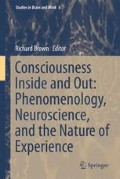Abstract
Although I am going to argue that we need not accept the conclusion expressed in Philip Goff’s title, I am grateful for the opportunity to comment on his paper. For I believe he has raised an important challenge that property dualism, and some other views, must face up to.
Access this chapter
Tax calculation will be finalised at checkout
Purchases are for personal use only
Notes
- 1.
Here, and elsewhere in these comments, I rely on some views about consciousness that I have explained and defended in Robinson (2004a). These views, of course, may not be accepted by all property dualists. However, what is needed to dispute Goff’s conclusion is only one coherent form of property dualism. It need not be shown that views that include property dualism, but are laden with certain further assumptions, cannot lead to panpsychism.
- 2.
Readers will rightly take this sentence as showing that I am not offering a HOT theory of consciousness. However, HOT theorists can accept the distinction I am making in this section. For them, consciousness tout court will be sensory episodes accompanied by unconscious thoughts that one is having them, while self-consciousness will involve sensory episodes accompanied by conscious thoughts that one is having them. For explanation of my views on higher order theories, see Robinson (2004a, b).
- 3.
One might suggest here that a self cannot gradually disappear. The text, however, shows how some aspects of a self appear in several guises, and can gradually be lost. My view is that other aspects of self go the same way. For more on the notion of a self, see Robinson (2010).
References
Mangan, B. 2001. Sensation’s ghost: The non-sensory “fringe” of consciousness. Psyche 7(18). Available at http://www.theassc.org/files/assc/2509.pdf
Robinson, W.S. 2004a. Understanding phenomenal consciousness. Cambridge: Cambridge University Press.
Robinson, W.S. 2004b. A few thoughts too many? In Higher-order theories of consciousness, ed. R.J. Gennaro, 295–313. Amsterdam: John Benjamins Publishing Company.
Robinson, W.S. 2010. Your brain and you: What neuroscience means for us. New York: Goshawk Books.
Author information
Authors and Affiliations
Corresponding author
Editor information
Editors and Affiliations
Rights and permissions
Copyright information
© 2014 Springer Science+Business Media Dordrecht
About this chapter
Cite this chapter
Robinson, W.S. (2014). A Wake Up Call. In: Brown, R. (eds) Consciousness Inside and Out: Phenomenology, Neuroscience, and the Nature of Experience. Studies in Brain and Mind, vol 6. Springer, Dordrecht. https://doi.org/10.1007/978-94-007-6001-1_8
Download citation
DOI: https://doi.org/10.1007/978-94-007-6001-1_8
Published:
Publisher Name: Springer, Dordrecht
Print ISBN: 978-94-007-6000-4
Online ISBN: 978-94-007-6001-1
eBook Packages: Humanities, Social Sciences and LawPhilosophy and Religion (R0)

